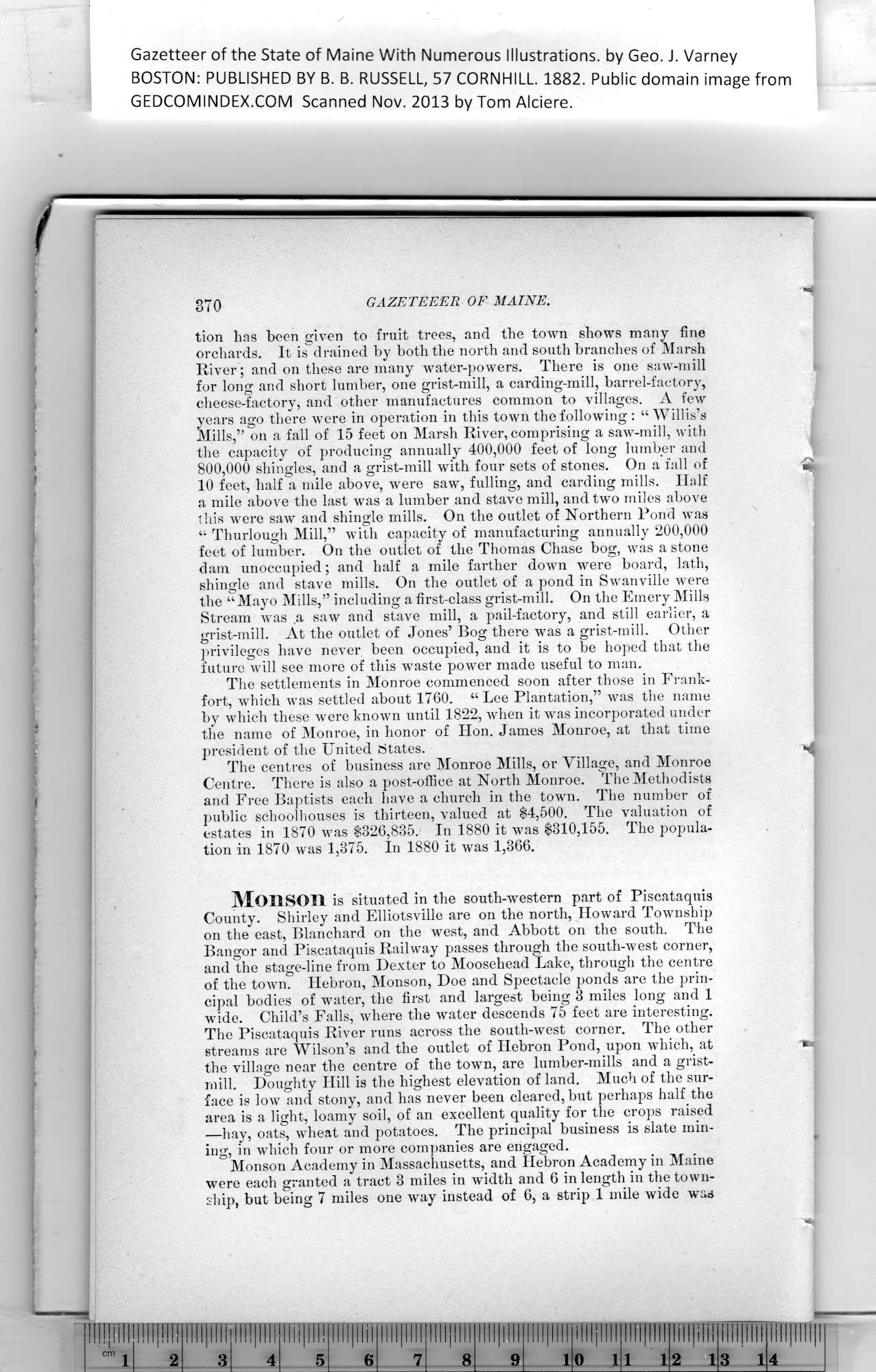|
Gazetteer of the State of Maine With Numerous Illustrations, by Geo. J. Varney
BOSTON: PUBLISHED BY B. B. RUSSELL, 57 CORNHILL. 1882. Public domain image from
370 GAZETEEyER OF MAINE.
tion has been given to fruit trees, and the town shows many fine
orchards. It is drained by both the north and south branches of Marsh
River; and on these are many wrater-powers. There is one saw-mill
for long and short lumber, one grist-mill, a carding-mill, barrel-factory,
cheese-factory, and other manufactures common to villages. A few
years ago there were in operation in this town the following : “ Willis’s
Mills,” on a fall of 15 feet on Marsh River, comprising a saw-mill, with
the capacity of producing annually 400,000 feet of long lumber and
800,000 shingles, and a grist-mill with four sets of stones. On a fall of
10 feet, half a mile above, were saw, fulling, and carding mills. Half
a mile above the last was a lumber and stave mill, and two miles above
this were saw and shingle mills. On the outlet of Northern Pond was
“ Thurlough Mill,” with capacity of manufacturing annually 200,000
feet of lumber. On the outlet of the Thomas Chase bog, was a stone
dam unoccupied; and half a mile farther down were board, lath,
shingle and stave mills. On the outlet of a pond in Swanville were
the “Mayo Mills,” including a first-class grist-mill. On the Emery Mills
Stream was a saw and stave mill, a pail-factory, and still earlier, a
grist-mill. At the outlet of Jones’ Bog there was a grist-mill. Other
privileges have never been occupied, and it is to be hoped that the
future will see more of this waste power made useful to man.
The settlements in Monroe commenced soon after those in Frank-
fort, which was settled about 1760. “Lee Plantation,” was the name
by which these were known until 1822, when it was incorporated under
the name of Monroe, in honor of Hon. James Monroe, at that time
president of the United States. ^
The centres of business are Monroe Mills, or Village, and Monroe
Centre. There is also a post-office at North Monroe. The Methodists
and Free Baptists each have a church in the town. The number of
public schoolhouses is thirteen, valued at $4,500. The valuation of
estates in 1870 was $826,885. In 1880 it was $310,155. The popula-
tion in 1870 was 1,375. In 1880 it was 1,366.
MOllSOll is situated in the south-western part of Piscataquis
County. Shirley and Elliotsville are on the north, Howard Township
on the east, Blanchard on the west, and Abbott on the south. The
Bangor and Piscataquis Railway passes through the south-west corner,
and the stage-line from Dexter to Moosehead Lake, through the centre
of the town. Hebron, Monson, Doe and Spectacle ponds are the prin-
cipal bodies of water, the first and largest being 3 miles long and 1
wide. Child’s Falls, where the water descends 75 feet are interesting.
The Piscataquis River runs across the south-west corner. The other
streams are Wilson’s and the outlet of Hebron Pond, upon which, at
the village near the centre of the town, are lumber-mills and a grist-
mill. Doughty Hill is the highest elevation of land. Much of the sur-
face is low and stony, and has never been cleared, but perhaps half the
area is a light, loamy soil, of an excellent quality for the crops raised
—hay, oats, wheat and potatoes. The principal business is slate min-
ing, in which four or more companies are engaged.
Monson Academy in Massachusetts, and Hebron Academy in Maine
were each granted a tract 3 miles in width and 6 in length in the town-
ship, but being 7 miles one way instead of 6, a strip 1 mile wide was
PREVIOUS PAGE ... NEXT PAGE
This page was written in HTML using a program written in Python 3.2
|
